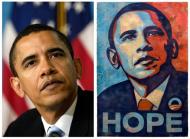As pretty much everyone is surely aware by now, the Associated Press has claimed that the iconic "HOPE" image created by Shepard Fairey for the Obama campaign, and featured on everything from posters to t-shirts to mugs to buttons, is an infringement of the copyright in an AP photograph of Obama, taken by Mannie Garcia.

Putting aside questions of whether the AP showed particularly good judgment in threatening Fairey with an infringement suit (it did not, imho), on the merits the AP claim looks very weak to me, on two grounds:
1. It's not an infringement of their copyright in the photo. Fairey admits that he copied from the photograph in making his image - but copying does not necessarily imply copyright infringement. You're allowed to copy things from others, if the things that you copy are not protected by copyright. Garcia's photograph is, certainly, a work protected by copyright — but only its "original" elements are protected. The photographer has no protection for depictions of what the world (including Pres. Obama) actually looks like, but only in the artistic and creative decisions that are given visible expression in the photo. There's certainly some of that in the photo — the background, for example, and perhaps the lighting and exposure that Garcia used. But what Obama looks like, and the tilt of his head, are not protected original elements of the photo, because they do not "owe their origin" to the photographer. And to my eyes, the things that Fairey copied are precisely those, unprotected elements of the photo. He didn't take the background, and he didn't take the lighting - those are the things he changed. What he took was Obama's face, and the tilt of his head — not infringment, to my eyes.
2. Even if Fairey copied copyrightable elements of the photograph, he's got a very, very strong fair use defense. One critical part of the fair use inquiry is: did the defendant have a "transformative purpose" in using the copyrighted original. That doesn't mean "did the defendant transform the original" - it means "did the defendant have a purpose significant different that the purpose for which the original was created. The AP photo was created for a purpose — as a news photograph. Fairely's purpose was completely different — he's making a political statement (duh!), and attempting to get voters to believe in the message of "hope," and all the rest. Courts have, in recent years, indicated that this factor is central to the fair use defense, and I think it gives Fairey a very strong case.
Prof. Jane Ginsburg, a prominent copyright law prof at Columbia Law School, is quoted here saying that she "questioned whether Fairey has a valid fair-use claim and says that he should have at least credited the AP.
"What makes me uneasy is that it kind of suggests that anybody's photograph is fair game, even if it uses the entire image, and it remains recognizable, and it's not just used in a collage," Ginsburg said. "I think that's pretty radical."
It is pretty radical - but it's also correct. Anybody's photograph is fair game — that's precisely what "fair use" is all about. "It is not infringement of copyright to make fair use of a copyrighted work," in the words of the Copyright Act — any copyrighted work, of any kind, anywhere, at any time, is fair game to be used, if it is used "fairly." And I don't think the failure to credit the AP has anything to do with that analysis — maybe it would have been nice for Fairey to give Garcia credit, but I do not believe that the law of fair use makes that a relevant consideration.
And finally, in the "be careful what you ask for, it might come back to bite you in the ass" department: now it turns out that the AP, having started this ruckus, might not even own the copyright in the photograph at all. Garcia is apparently claiming that he, and not the AP, is the copyright owner, because (a) he was not an employee of the AP when he took the photo (which would give the AP the copyright under the "work for hire" doctrine", and (b) that his contract with the AP does not transfer his copyright to them. So the end product of all this may well be that the AP has no claim against Fairey, and no copyright at all in the photo.
[Update -- Randy Picker, over at the U Chicago Law School faculty blog, has a somewhat more extensive analysis reaching basically the same conclusion as I do above - DavidP]